How to Respond to Negative Reviews? 8 Golden Rules
Table of contents
Ryanair’s online reputation is no stranger to turbulence.
Recently, a window seat controversy stirred up red-hot discussions across review sites and social media. On October 25, 2024, Ryanair received 850 negative reviews, reaching over 5 million users! Twitter led the wave of backlash, with disgust as the dominant emotion.
How did Ryanair handle the fallout? And how can you respond in a similar situation?
Read on to find out.
How to respond to negative reviews? Find the most important ones, be fast, detect negative topics, stay calm & apologize, find the channels of negativity, offer solutions, constantly monitor sentiment around your brand, and turn negative feedback into positive reviews. Read on for more details.
When you get a negative review, it is not the end of the world!
But it might be… if you don’t act quickly and respond professionally.
In today’s digital landscape, potential customers are more likely than ever to read reviews before making a purchase, selecting a service, or booking a hotel room.
Why would they choose your business if not only do you have poor reviews, but you also ignore them?
The best approach is to acknowledge every negative review.
There’s a silver lining to this: responding thoughtfully can create a positive impact.
Your customers will appreciate feeling seen and understood.
Your willingness to engage speaks volumes, even if you can’t resolve the issue immediately.
So, where should you begin?
How to quickly find the most important negative reviews?
There are two ways of tracking online reviews: the slow one and the smart one.
The former relies on manually searching the web, social media platforms, review sites, and other relevant sources.
As you can imagine, it takes hours and is not very effective as it doesn’t guarantee that you will find all the key reviews.
Alternatively, you can find all your reviews in one neat dashboard.
This is possible with media monitoring tools.
They crawl publicly available online sources in search of your chosen keywords. When they find one, they display it in the tool’s dashboard.
For instance, like this:
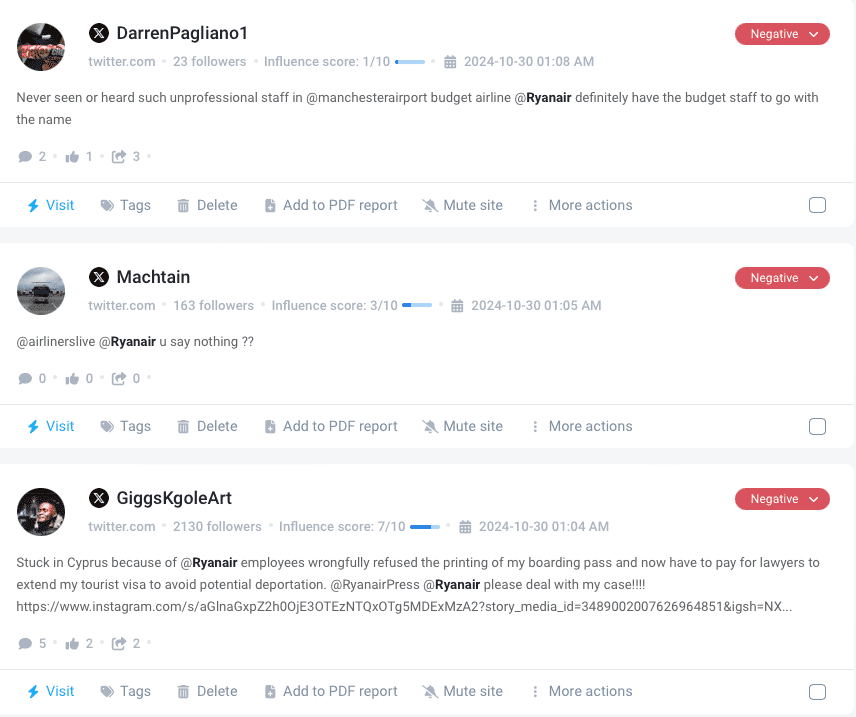
What’s great about using a dedicated media monitoring tool is that it not only collects mentions but also enables filtering options and calculates metrics that allow you to track your brand reputation and performance over time.
Monitor negative reviews with no effort!
If you want to quickly spot all the most important negative reviews, use the following filters:
- Sentiment – set the sentiment filter to negative.
- Influence score – the higher the influence score, the more impact a negative review can have, as it is written by a famous creator and gets a lot of attention.
- Importance – use this filter to see only the most relevant reviews.
- Intent – choose particular intents to analyze.
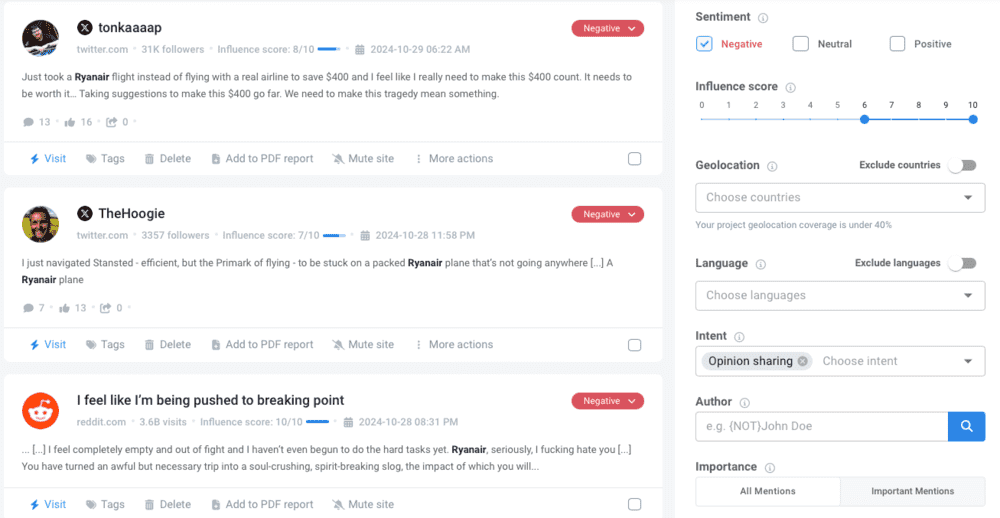
So, if you want to stay up to date with your negative and positive reviews, do you have to check your panel every day? Or maybe even several times a day?
The answer is no!
We have customizable alert features to save you time. You can decide on the frequency, requirements, restrictions, and type of notifications.
When you get an alert, you can glance at the Anomaly Detection feature in your panel.
This AI-powered innovation detects sudden spikes in your brand reach and mention volume.
Secondly, it analyzes all the mentions from that day to determine the reason behind the anomaly.

It’s so simple and saves you a lot of time, as you don’t have to manually browse the mentions to find the reason for the sudden negativity peak.
Build a positive online reputation with Brand24.
How to Respond to Negative Reviews? 8 Golden Rules
01 Focus on the most important negative reviews first
Of course, you should treat all customer feedback seriously and respectfully, regardless of who shares it.
However, some individuals’ negative feedback may be particularly harmful to your business reputation. These are influencers, celebrities, and other people with broad social media reach.
Their bad reviews won’t go unnoticed and can destroy your brand image.
Fixing the situation will then require an extensive online reputation repair strategy and the help of crisis management software.
You don’t want that, right?
Thankfully, you’ll find all the most critical negative feedback in the Analysis tab of your Brand24 panel.
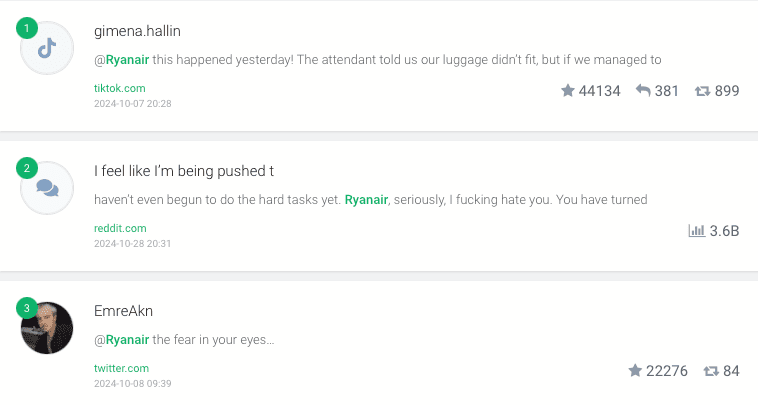
Find and respond to negative reviews with Brand24.
Let’s take the first review. It comes from TikTok where it generated 44k likes, 900 shares, and 380 comments in just 3 weeks!
And while the comments look like these:

Ryanair hasn’t posted any review response so far.
This is a strategic mistake that may backfire on Ryanair if the company will keep ignoring their customers.
02 Be fast
Responding to reviews in a timely manner is key to your success, especially when it comes to negative reviews.
The best customer service is real-time. It would be perfect if you could address every dissatisfied customer immediately.
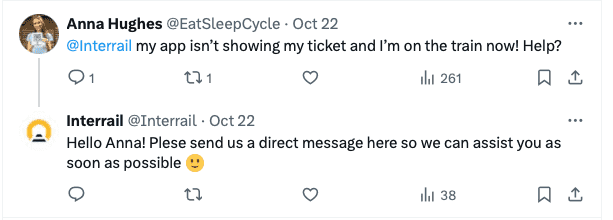
However, that might be challenging, I know.
Thus, the rule of thumb is to reply, preferably within 24 hours.
You can extend it to 48 hours if you receive so many negative reviews that your customer service team cannot immediately contact unhappy customers.
But remember, first, you should divide the mentions into the more and less important ones.
In the end, ensure that no unhappy customer is left without a response.
This is a key step in building brand loyalty.
03 Find topics that attract negative reviews
Some topics around your brand may generate particularly many negative reviews.
Detecting those topics will allow you to solve the negative review problem globally.
For instance, in Ryanair’s case, many people complain about baggage policies, flight delays and compensation, and poor customer service.
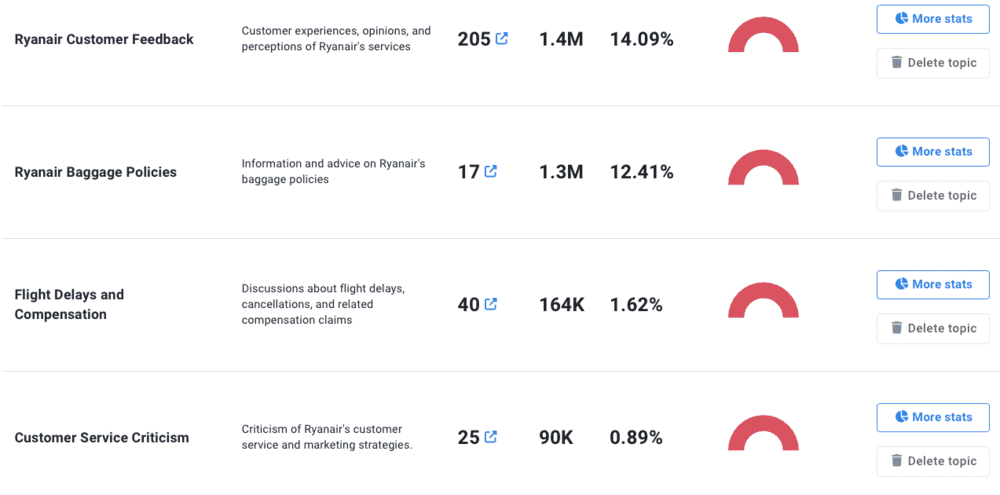
Working on those three aspects could help Ryanair improve its overall online reviews and customer satisfaction.
Find your dissatisfied customers with Brand24!
04 Remain professional & apologize
Sometimes, you may feel that negative feedback is unfair.
That’s okay.
But never do what this one hotel does with all their negative reviews.
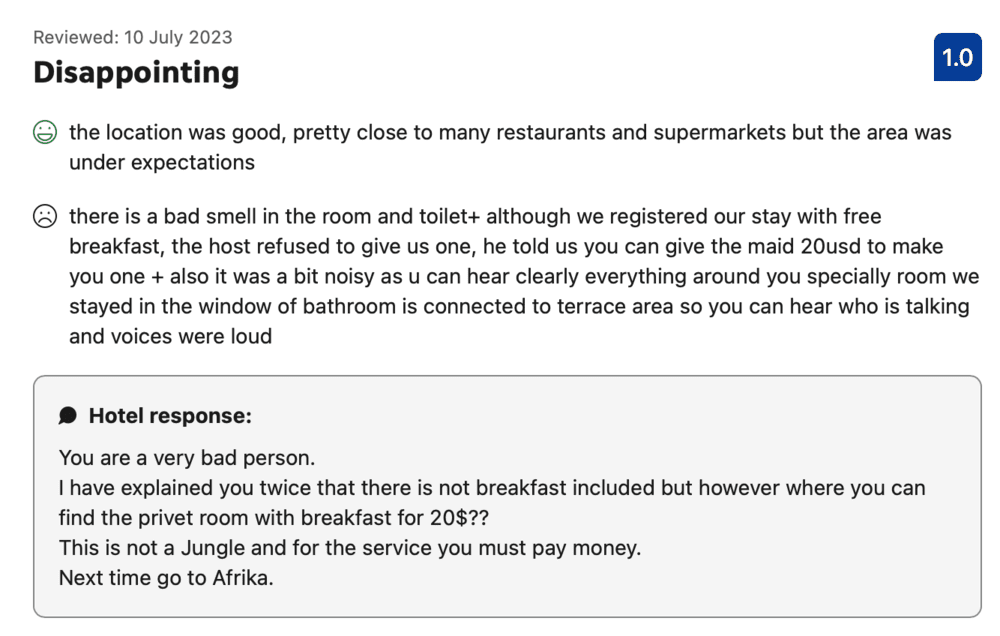
It is unbelievable how this hotel treats its customers.
Seeing this unprofessional reply, most customers will probably look for a different place to stay.
And what to do if a review is clearly aimed at harming your business?
If a review is clearly fake, try to prove that.

However, otherwise, always respect your customer’s experience and opinion.
How to respond to negative reviews professionally?
- Personalize it – use the customer’s name and refer to this specific customer experience – don’t keep it generic.
- Apologize – it’s so simple, but it matters so much! Depending on the seriousness of the situation, you can say, ‘I would like to sincerely apologize for XYZ,’ or “I’m sorry to hear that XYZ.’
- Thank for the feedback – always see your customer’s feedback as a chance to improve.
- Acknowledge the bad experience – sympathize with the customer experience and express understanding.
- Explain the situation – don’t excuse yourself forcefully, but let the customer know about the reason for their negative experience.
- Promise a better experience – ask the customer to give you a second chance and compensate for their previous bad experiences. Depending on your business type, you can also offer some kind of compensation, like a discount or a drink on the house, a room upgrade, a free item, or whatever else you can do.
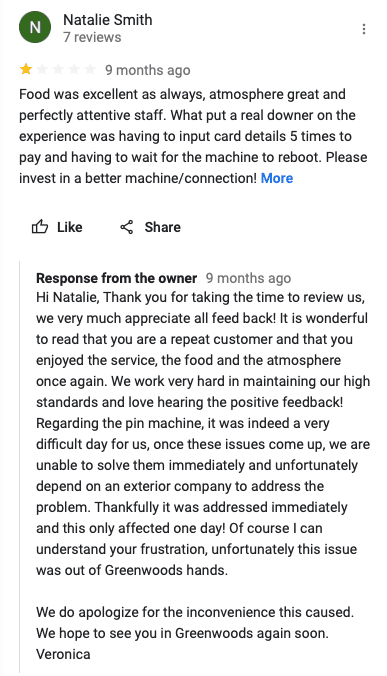
As you can see above, this customer is very strict when rating their experience. She is happy with the food, atmosphere, and staff but still gives only one star because of some problems with card payment.
To me, the rating seems too strict, but fortunately, the business owner did not lose her temper and replied in a professional manner. That’s a good job!
05 Find channels that attract negative reviews
It is crucial as it is yet another step toward solving the problem of negative reviews globally by providing excellent customer service.
Using a sentiment analysis tools, such as Brand24, you can easily detect the source of negativity.
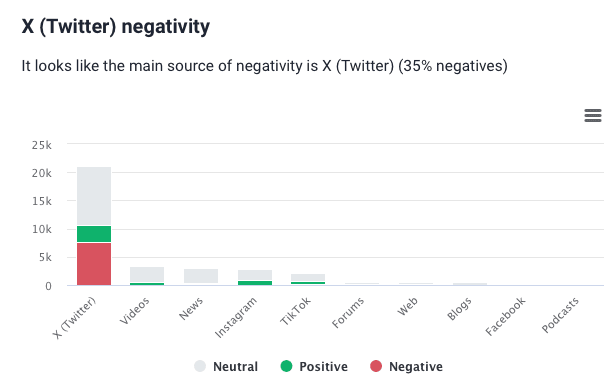
The source of negativity may be related to your target audience or how different audience segments find your product or service.
For instance, if you get positive reviews on TikTok but negative feedback on Facebook reviews, maybe your product is too complicated for the older generation to grasp, but it is appreciated by young audiences who are more tech-savvy.
By analyzing those dependencies, you’ll learn the reason behind your negative reviews and will be able to better satisfy all your customers’ needs.
Respond to negative reviews more efficiently than ever.
06 Offer solutions
Nice words and apologies are important, but the problem solution counts the most.
Don’t just limit your review response to saying that you’re sorry. Find ways to make up for the negative experience.
Mention possible refunds, offer complimentary service or a discount.
Additionally, it might be helpful to keep one style and tone of voice in your responses.
This way, your customers will know what to expect when they tag you in their negative review.
Here, you can see a professional and official Ryanair review response that aims to solve the client’s problem.
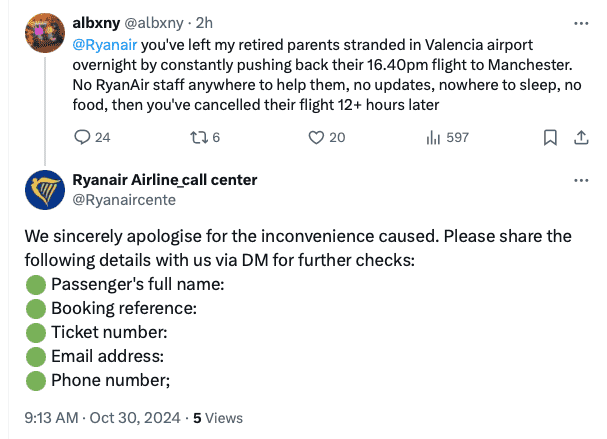
Ryanair tries to take the conversation from the public channel, which is a common practice.
Is it a good practice, though?
I’ll go back to that in the chapter 08.
For now, let’s focus on a different Ryanair’s review response.

While we all know Ryanair’s sarcastic approach to marketing, this customer may be disappointed with how the company treated them.
Many people enjoy Ryanair’s funny approach and don’t mind being roasted by the company.
However, in this case, it is unclear if the negative reviewer expected just a playful reply or actually wanted to voice their concerns.
In the latter case, the company’s inappropriate reaction may attract more negative reviews and harm Ryanair’s reputation online.
07 Keep an eye on the sentiment of reviews
Long-term brand performance is the key to your success if you want to build a loyal customer base.
Customer satisfaction should be your priority.
The below negative reviews of Ryanair clearly show the state of their business reputation management.
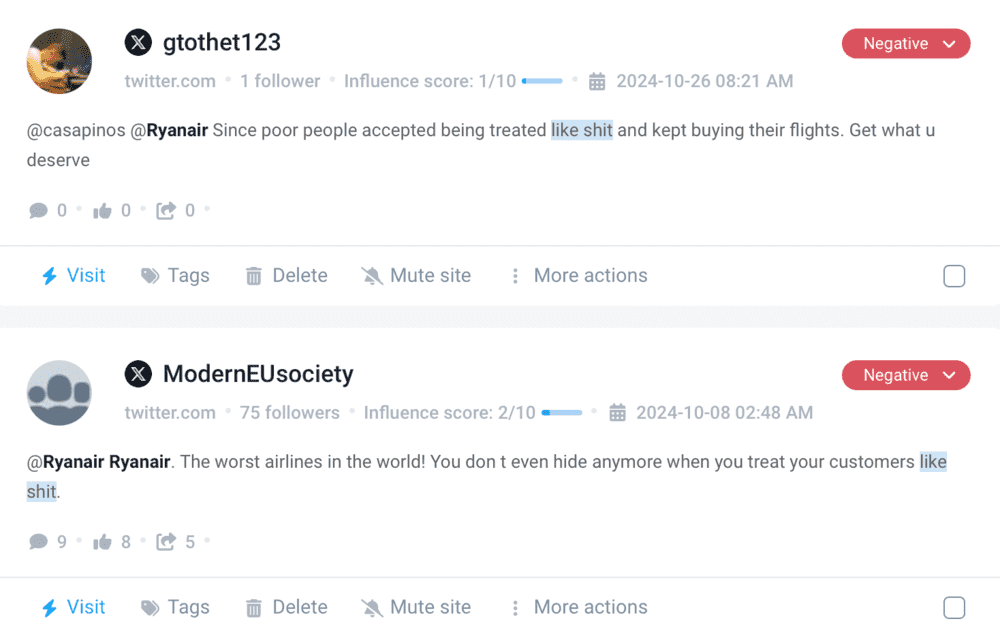
The way to avoid negative reviews for Ryanair would probably be crazy long.
In that journey, Brand24 turns out to be a great helping hand.
Our tool offers sentiment analysis. This way, you can easily check the number of your negative reviews versus positive ones.
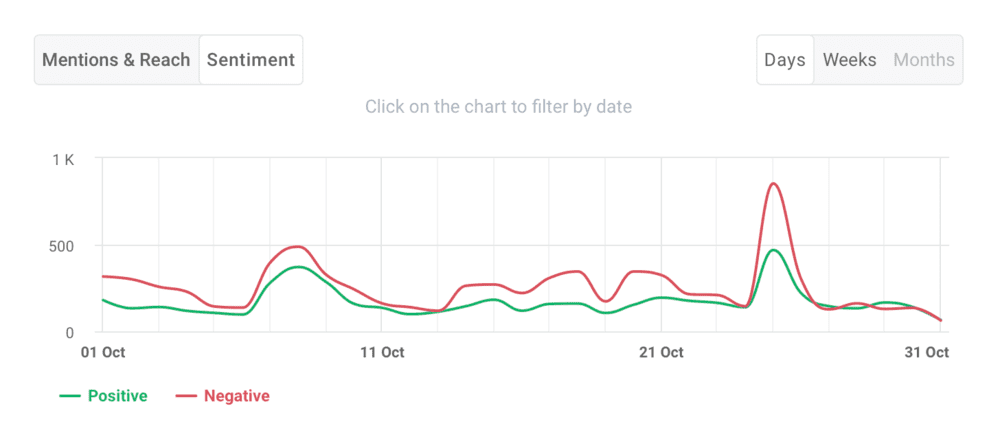
When you see that the negative sentiment peaks, there are several actions you can take.
Start by checking the reasons behind the situation. You can leverage our Topic Analysis or check for any anomalies detected.
Find the main controversies generating negative reviews and try to tackle the issue globally.
Do your best to provide exceptional service at the time and encourage happy customers to post online reviews to balance the negativity.
At the same time, address each customer individually to ensure a personalized experience.
Negative reviews are valuable insights into improving your business. Honest feedback can be really useful, so always treat it with kindness and appreciation.
If your business receives many negative reviews, it may be a sign that major changes are needed to improve the customer experience and your overall reputation.
08 Turn negative feedback into positive reviews
That is the next level of online reputation management!
It is not always easy, but it’s definitely worth it.
In point 06, Offer solutions, I told you about a common practice of taking the conversation offline or off public channels.
Sometimes, it is necessary, for instance, to ask your customer for personal details like an order, flight, or phone number.
However, when that’s not the case, you can easily continue the discussion in public.
Why should you do that?
This way, all the potential customers reading your negative reviews will see your engagement in addressing the customer’s concerns.
But not only that.
Often, after you’ve helped your negative reviewer solve their problem, they’ll thank you for your support, praise your customer support team, or simply appreciate your engagement.
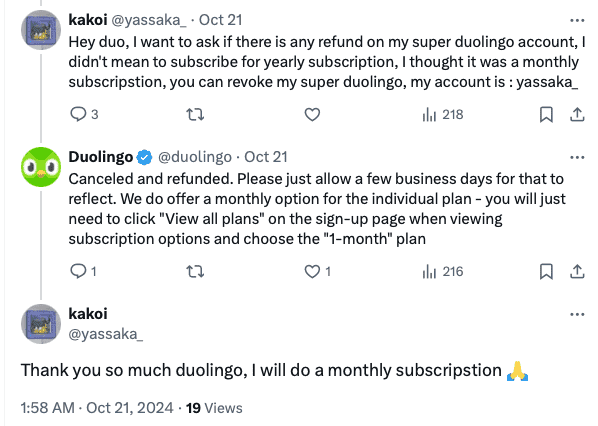
This kind of testimonial is key for potential customers.
This way, they can see your approach to your customer’s experience and be reassured that you’ll be a helpful hand even if they encounter difficulties.
Otherwise, when you solve a problem through direct message, other people won’t know if you indeed helped the reviewer.
They’ll just see that you moved the conversations from public view.
Turn negative experience into positive reviews!
How to respond to negative reviews fast?
If you want to create review responses efficiently, AI software can make the process much smoother!
You could use ChatGPT, of course—but that involves manually finding each review, copying and pasting them one by one, and then returning to paste the AI-generated responses.
It works, but it’s not the most efficient approach.
Thankfully, there’s a better way: the AI Brand Assistant available in your Brand24 dashboard. This powerful automation tool takes care of everything for you:
- It finds online mentions and reviews.
- Analyzes their sentiment.
- Generates responses tailored to each negative review.
With AI Brand Assistant, managing your brand’s reputation becomes faster and more streamlined, freeing you up to focus on other important tasks!
Let’s take a look at a few examples.
Prompt: Generate example responses to specific negative reviews
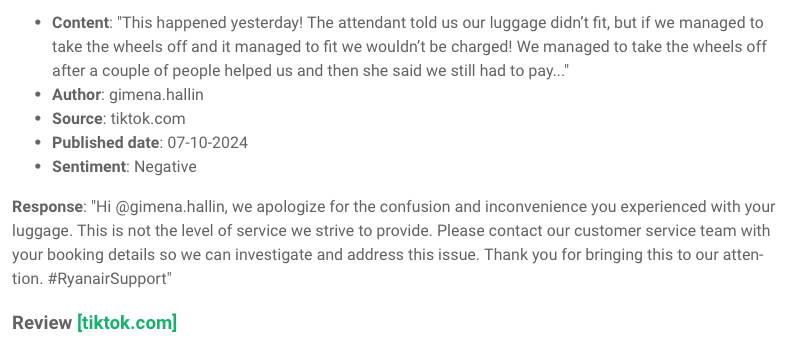
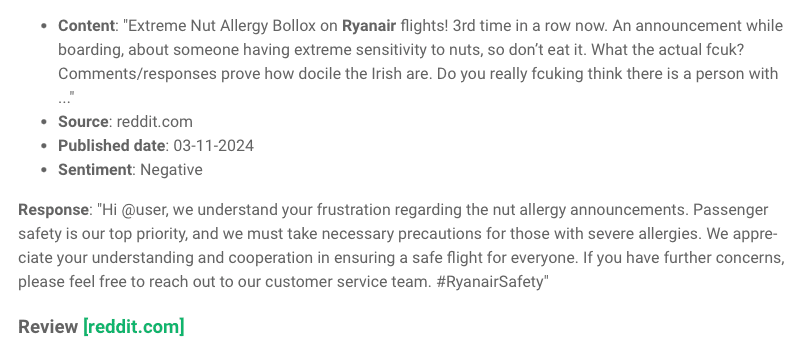
Alternatively, you can find the most relevant negative mentions in your panel by sorting them according to Influence Score or Relevance and then ask our AI Brand Assistant to answer them.
Prompt: Generate response to this negative mention: @Ryanair There s a bug in your app: it won t accept d.o.b. of infant for check-in.
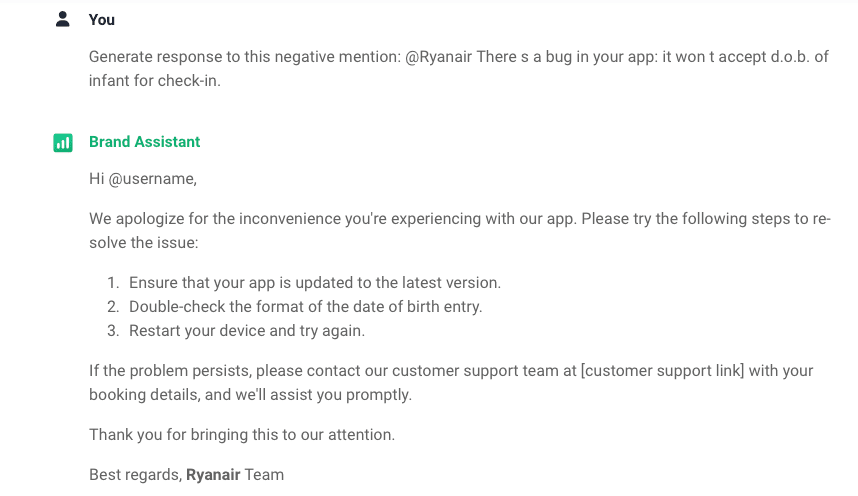
Respond to negative reviews like a PRO!
Negative review response examples
At this point, you know the whole theory needed to respond to negative reviews.
Now let’s look at some practical examples of how to respond to business negative reviews.
Interestingly, while searching for examples of how businesses handle bad reviews, I found it surprisingly challenging to locate any truly effective ones.
Many companies either ignore negative reviews altogether or respond in ways that fall short of expectations.
This represents a significant oversight in customer engagement, meaning that if you manage this area effectively, you could gain a competitive edge over your rivals!
That said, let’s get down to an example of a great review response.
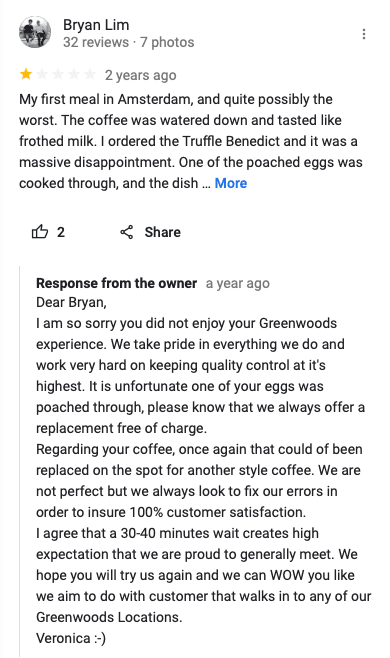
This response expertly addresses several key aspects that help diffuse negativity and foster goodwill:
- Personal Addressing: Using the reviewer’s name (“Dear Bryan”) makes the response feel personalized and shows that the business is attentive to individual feedback.
- Sincere Apology: Acknowledging the issue with an apology demonstrates accountability, which can quickly defuse tension.
- Values-Based Approach: Emphasizing the business’s commitment to “high quality, professional customer service, and customer satisfaction” reinforces its core values and commitment to improvement.
- Compensation Offer: Mentioning possible compensation, like replacing food or drink, shows that the business is willing to make things right, which can rebuild trust.
- Invitation to Return: Inviting to revisit the business with a promise of a better experience extends goodwill and reinforces a commitment to customer happiness.
- Personal Signature: Signing the response with the author’s name adds a human touch, making the response feel more genuine and less scripted.
These thoughtful elements transform a negative review into a powerful opportunity for the business to showcase its values and commitment to customer satisfaction.
The response is so well-crafted that it addresses the initial complaint and highlights the business’s strengths, turning the review into a positive reflection of its dedication to service and improvement.
By acknowledging the issue, showing empathy, and offering a solution, the response suggests that Bryan’s unpleasant experience was likely a rare occurrence rather than a pattern of poor service.
In this case, Veronica’s response actually strengthens the restaurant’s reputation.
Her genuine, solution-focused reply reassures future customers, making it more likely they will give Greenwoods a try, trusting that any issues will be handled with professionalism and care.
How to use negative review response templates?
There are many negative review response templates available online. You may feel tempted to use them as they promise faster management of bad reviews.
Unfortunately, those templates are designed to be universal so that every business can use them.
Because of this, they may fail to address a particular bad review appropriately.
Thus, if you want to streamline your review management, I’d recommend social listening tools that support reputation management. As you already know, Brand24 is one of them.
Monitor review sites with Brand24!
If you prefer to continue using templates, here are some fundamental principles and tips to keep in mind:
- Create multiple templates tailored to different review sites or types of cases.
- Ensure each response is personalized enough to feel genuine.
- Address all the main points mentioned in the negative review.
- Consider crafting a custom response in unique or complex situations rather than forcing the problem to fit a template.
Below, you can find a universal yet efficient review response template that addresses all the key aspects of a potential bad review.
Negative review response template
Dear [customer name]
Thank you for taking the time to share your valuable feedback regarding your experience with [Your Company Name]. We genuinely appreciate hearing from our customers, as it helps us identify areas for improvement.
We are sorry to hear that your experience did not meet your expectations. [Briefly address the specific issue mentioned in the review, showing empathy. For example: “We apologize for the inconvenience you experienced with the shipping process.”]
At [Your Company Name], we strive to provide [mention your key values, such as excellent customer service, quality products, etc.]. We clearly fell short in this instance, and we’re committed to making things right.
To resolve this, we would like to [mention specific actions you will take to address the issue, such as offering a refund, replacement, etc.].
Please contact us directly at [Your Contact Information] so we can assist you further and ensure your concerns are addressed promptly. [This part should be added only when resolving the problem requires revealing direct contact information or other confidential personal data that should not be shared publicly. Otherwise, you should continue the chat where it was initiated to show how you handle customer issues]
Thank you once again for your valuable feedback. We hope to have the opportunity to restore your faith in us and provide you with a better experience in the future.
[Your name]
Why should you respond to negative reviews?
Responding to negative reviews is crucial for any business, as it directly influences potential customers’ purchasing decisions.
In today’s digital landscape, consumers rely heavily on online reviews to guide their choices, often relying on others’ experiences to assess the quality and reliability of a product or service.
That’s also what Hamish McRae, one of Europe’s foremost speakers on global future trends in economics, business, and society, says about reviews in his book “The World in 2050”.
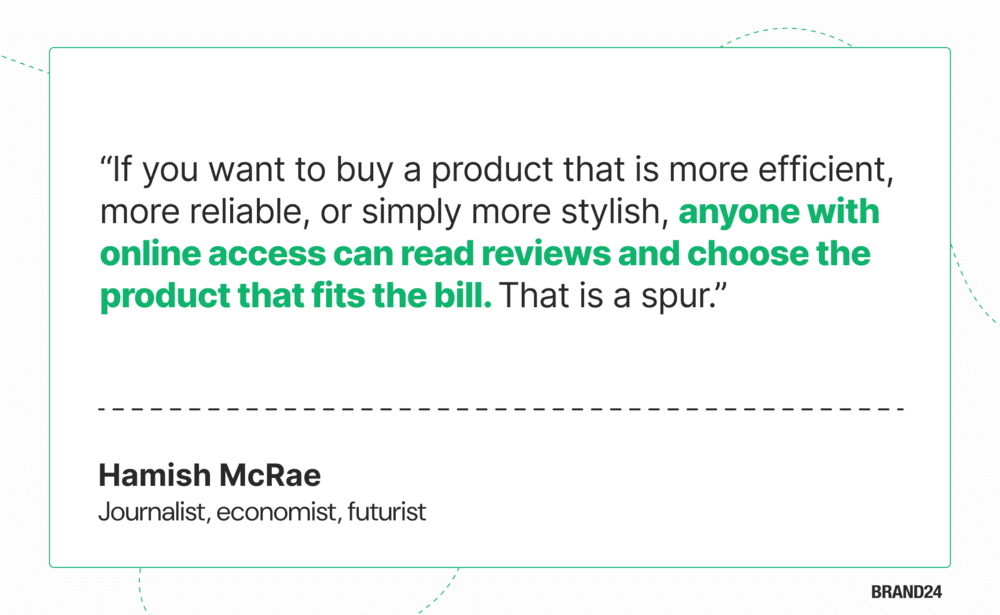
However, this does not mean negative or neutral reviews are the end of your business.
You still can act to show your dedication to continuous improvement.
Engaging with negative feedback not only demonstrates a commitment to customer satisfaction but also showcases transparency and accountability.
This proactive approach can help mitigate the impact of negative perceptions and build trust with prospective buyers.
Here are some reasons why responding to negative reviews is important:
- Customer Engagement: Responding shows that you value customer feedback and are engaged with your audience.
- Reputation Management: Addressing negative reviews can help mitigate damage to your business reputation and demonstrate transparency.
- Opportunity for Improvement: Negative feedback can highlight areas for improvement in your products or services. Remember, not all negative reviews are bad for your brand!
- Building Trust: A thoughtful response can build customer loyalty and trust with both the reviewer and potential customers who read the review response.
- Resolution of Issues: Engaging with dissatisfied customers allows for the opportunity to resolve their issues, potentially turning a negative experience into a positive one.
- Influencing Potential Customers: Prospective customers often read reviews; a prompt and constructive response can influence their purchasing decisions positively.
- Encouraging Positive Reviews: When you show you care about feedback, customers may be more inclined to leave positive reviews in the future.
- SEO Benefits: Responding to reviews can improve your online visibility and search engine rankings by generating fresh content related to your brand.
- Demonstrating Professionalism: A well-handled response to criticism showcases your professionalism and commitment to customer service.
Monitor review sites with Brand24!
Conclusion
Now that you understand how to respond effectively to negative reviews, it’s time to put these strategies into practice.
With the right tools, examples, and techniques, you’re well-equipped to transform critical feedback into valuable insights and opportunities for growth.
Every response you craft not only addresses customer concerns but also highlights your brand’s commitment to continuous improvement and customer satisfaction.
Remember, thoughtful and professional responses reflect your brand’s values and build trust.
By consistently engaging with reviews – both positive and negative – you’re showing current and future customers that you value their voices.
This commitment can turn dissatisfied clients into loyal advocates and demonstrate your dedication to quality service.
So, don’t wait—start monitoring your reviews today. Let each response become a testament to your customer-first approach, helping to build a strong reputation and lasting relationships.
Embrace feedback as a powerful tool, and watch as it strengthens your brand’s foundation!
Key takeaways:
- Remember the 8 golden rules when you respond to negative reviews:
- 01 Focus on the most important negative reviews first
- 02 Be fast
- 03 Find topics that attract negative reviews
- 04 Stay calm & apologize
- 05 Find channels that attract negative reviews
- 06 Solve the problem
- 07 Keep an eye on the sentiment of reviews
- 08 Turn negative feedback into positive feedback
- Leverage business automation software to easily find and manage every bad review.
- For efficiency, access all your reviews from one dashboard, including Instagram, TikTok, X (Twitter), and Facebook reviews, Google reviews, and mentions from any other review site.
Monitor your company name online to find all the key reviews!



